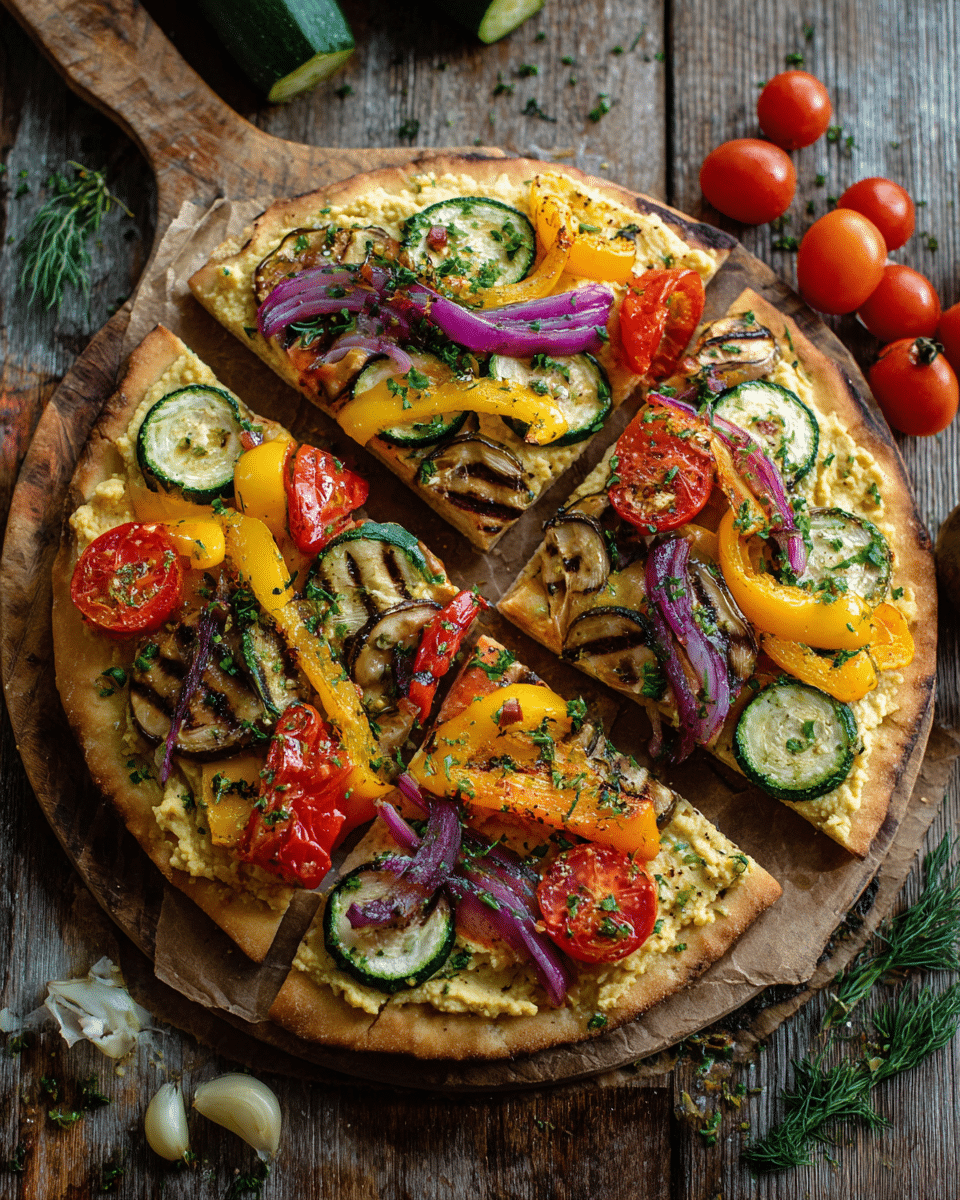This Summer Veggie Flatbread with Hummus is a fresh, vibrant, and satisfying meal perfect for warm-weather lunches or light dinners. It’s loaded with colorful grilled vegetables, creamy hummus, and fragrant herbs, all served on a crisp flatbread for the ultimate plant-based treat.
FULL RECIPE
Ingredients
- 2 whole-wheat flatbreads or naan
- 1 cup hummus (store-bought or homemade)
- 1 small zucchini, sliced into thin rounds
- 1 small yellow squash, sliced
- 1/2 red bell pepper, sliced
- 1/2 red onion, thinly sliced
- 1/2 cup cherry tomatoes, halved
- 1 tablespoon olive oil
- Salt and pepper, to taste
- 1/4 teaspoon garlic powder
- 1/4 teaspoon dried oregano
- Fresh basil leaves, for garnish
- Optional: crumbled feta cheese or nutritional yeast
Directions
- Preheat grill or grill pan over medium-high heat.
- Toss zucchini, squash, bell pepper, and onion with olive oil, garlic powder, oregano, salt, and pepper.
- Grill vegetables for about 3–5 minutes per side until tender and lightly charred.
- Warm the flatbreads on the grill or in a dry skillet for 1–2 minutes per side.
- Spread hummus evenly over the flatbreads.
- Top with grilled vegetables and halved cherry tomatoes.
- Garnish with fresh basil and optional toppings like feta or nutritional yeast.
- Slice and serve immediately.
Nutritional Information
- Calories: 350
- Total Fat: 18g
- Saturated Fat: 2.5g
- Cholesterol: 0mg
- Sodium: 400mg
- Total Carbohydrates: 38g
- Dietary Fiber: 7g
- Sugars: 6g
- Protein: 10g
- Vitamin A: 30% DV
- Vitamin C: 80% DV
- Calcium: 6% DV
- Iron: 15% DV
Health Benefits of Summer Veggie Flatbread with Hummus
This flatbread is a nutrient powerhouse thanks to its combination of fresh vegetables and hummus. The grilled zucchini, squash, bell peppers, and tomatoes provide a rich source of vitamins A and C, antioxidants, and dietary fiber, which support immune function, skin health, and digestion. Hummus, made primarily from chickpeas, offers plant-based protein and healthy fats, helping to keep you full and satisfied while supporting heart health. This makes the flatbread an excellent choice for anyone looking to eat a balanced, wholesome meal.
Why Whole-Wheat Flatbread is a Better Choice
Using whole-wheat flatbread instead of refined white bread boosts the fiber content significantly. Fiber aids digestion, helps regulate blood sugar levels, and promotes satiety, which can prevent overeating. Whole grains also provide essential nutrients like B vitamins, iron, and magnesium. Incorporating whole-wheat flatbread makes this dish not just tasty but also more nourishing and supportive of long-term health goals.
The Role of Grilled Vegetables in Flavor and Nutrition
Grilling vegetables intensifies their natural sweetness and adds a smoky depth of flavor that raw veggies can’t match. This method also helps retain most of the vegetables’ nutrients while offering a pleasant texture contrast. The slight char from grilling contributes a satisfying bite to the flatbread, making each mouthful flavorful and exciting without the need for heavy sauces or dressings.
Hummus: More Than Just a Spread
Hummus is a creamy blend of chickpeas, tahini, olive oil, lemon juice, and garlic, packed with nutrients and flavor. Chickpeas provide protein and fiber, making hummus an excellent plant-based protein source. Tahini adds healthy fats and a subtle nutty taste, while olive oil contributes heart-healthy monounsaturated fats. This combination not only enhances the taste but also adds to the flatbread’s nutritional profile, promoting sustained energy release.
Versatility of the Summer Veggie Flatbread
One of the best aspects of this recipe is its flexibility. You can easily swap in seasonal vegetables or add your favorite toppings, such as olives, artichokes, or avocado slices. This makes it a perfect base for customization depending on what you have on hand or your dietary preferences. The flatbread can be served warm or at room temperature, making it ideal for picnics, quick lunches, or light dinners.
How This Recipe Fits Into a Plant-Based Diet
For those embracing a plant-based lifestyle, this flatbread delivers a wholesome meal without relying on animal products. The hummus offers a satisfying alternative to cheese or meat, while the vegetables provide essential micronutrients and fiber. Even non-vegetarians can enjoy it as a delicious way to add more plants to their diet, helping to reduce overall meat consumption and improve heart and gut health.
Perfect for Meal Prep and On-the-Go Eating
Because the grilled vegetables and hummus can be prepared ahead of time, this flatbread is ideal for meal prepping. You can grill a batch of veggies and keep them refrigerated for several days, making assembly quick and convenient. It also travels well, so it’s a great option for packed lunches or healthy snacks when you’re busy and need something nutritious on the go.
Pairing Suggestions and Serving Ideas
This flatbread pairs wonderfully with a fresh green salad, a bowl of soup, or a simple side of roasted potatoes for a more filling meal. Adding a drizzle of balsamic glaze or a sprinkle of chili flakes can elevate the flavor profile. For a Mediterranean-inspired meal, serve it alongside olives, pickled vegetables, or a light cucumber yogurt dip.
Cultural Influences Behind the Ingredients
The combination of hummus and flatbread is rooted in Middle Eastern cuisine, where chickpeas and flatbreads have been staples for centuries. Grilled vegetables are commonly featured in Mediterranean diets, known for their health benefits and delicious flavors. This recipe reflects a fusion of these culinary traditions, adapted into a simple, modern meal that’s accessible and easy to prepare.
Sustainability and Seasonal Eating
Using summer vegetables promotes eating seasonally, which is better for the environment and often more economical. Seasonal produce tends to be fresher, more flavorful, and less reliant on energy-intensive storage and transport. Choosing plant-based ingredients like chickpeas also supports sustainability by reducing the environmental footprint compared to meat-heavy meals.
Nutritional Balance and Satiety
This recipe balances carbohydrates from the flatbread, fiber and vitamins from vegetables, and protein and healthy fats from hummus. This combination helps to regulate blood sugar levels and provides long-lasting energy. The fiber content also aids in digestive health and keeps you feeling full, reducing the temptation to snack on less healthy options later.
How to Adapt for Dietary Restrictions
The recipe is naturally gluten-free if you substitute flatbread with gluten-free alternatives like corn tortillas or gluten-free pita. It’s also vegan, making it suitable for a wide range of dietary needs. For those with nut allergies, be sure to check the hummus ingredients if it contains tahini (sesame seed paste). Adjusting the recipe is simple, allowing everyone to enjoy this tasty dish.
Conclusion
The Summer Veggie Flatbread with Hummus is more than just a quick meal; it’s a vibrant, nutrient-rich option that fits well within healthy, sustainable, and versatile eating patterns. Its roots in Mediterranean and Middle Eastern cuisine bring timeless flavors and health benefits, while its flexibility allows for endless customization. Whether you’re looking for a light lunch, a plant-based meal, or a flavorful way to enjoy seasonal veggies, this flatbread recipe offers a satisfying, wholesome solution.






